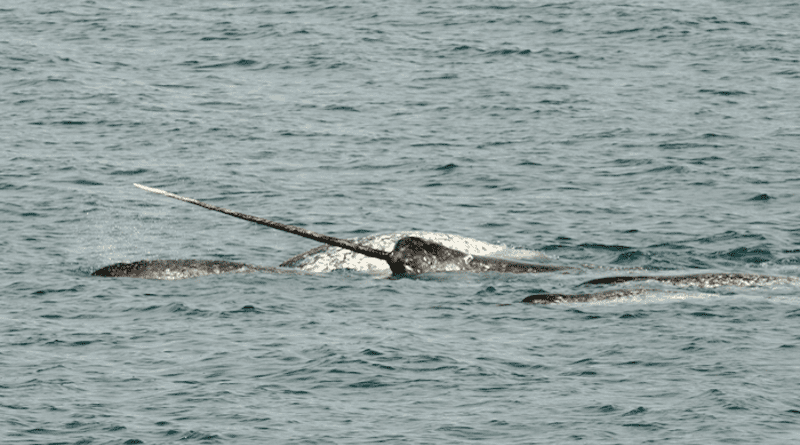As Sea Ice Retreats, Narwhals Are Changing Their Migration Patterns
Narwhals are changing their migration patterns in response to pressure from changing Arctic climates, a new UBC report has found.
Narwhals are the perfect Arctic animal for a migration study. These culturally-significant whales are considered to be among the most sensitive Arctic marine mammals to the effects of climate change. They are thought to live over 100 years old, and are seasonally migratory, with migratory patterns that include travel from shallow, ice-free waters to wintering grounds with over 95 per cent ice coverage. Since narwhals can be so long-lived, changes in behaviour may be one of the few recourses to adjust to the new normal of a changing Arctic.
The timing of migration appears to be changing over the longer time frame, matching changes in climate-driven sea-ice loss across the region. This study used satellite measurement devices to observe narwhal behaviour, including when they switched their behaviour into a migratory mode, when they left the summering areas, and how direct their movements were.
“We looked at satellite tracking data spanning 21 years from the Canadian Arctic, and found significant delays in the timing of narwhal autumn migrations, where narwhals were remaining longer in their summer areas at a rate of 10 days per decade,” said Dr. Courtney Shuert, lead author and post-doctoral fellow in the Statistical Ecology Research Group in the University of British Columbia’s Institute for the Oceans and Fisheries (IOF). “There were also sex-specific differences in departures, with the male narwhals starting the migration out of the summering areas, while females potentially with dependent young departing later by almost a week.”
Narwhals have shown a preference for cold water, and their space use is largely tempered by ice cover and the availability of open water regions. As a result, narwhals may be residing in coastal waters within the larger summering areas, until ice formation in the autumn and an increasing risk of entrapment, forces movement over deeper water towards the wintering areas in central Baffin Bay.
These changes in habit predictability due to climate shifts that have resulted in narwhals remaining longer in their summering areas, likely adjusting within a single individual lifetime, and will help us better understand how marine mammals in the High Arctic are adapting to climate change, Shuert said.
Does this change in behaviour means that narwhals will be able to adapt to climate change? “Unfortunately, departing later is not necessarily good news for the narwhal,” said Dr. Marie Auger-Méthé, senior author and an associate professor in the IOF. “Because staying in the summering grounds could results in further exposure to shipping traffic associated with the new iron mine, it may not be beneficial to the narwhals in the long term. We know they are sensitive to shipping disturbance, and that their stress levels have been rising over the part 20 years. In addition, staying in their summering grounds longer could increase the chance of narwhals being caught in quickly freezing ice. Such ice entrapments can kill hundreds of narwhals.”
Climate change and loss of sea ice is creating stressors for these animals, and they are adapting to a new life in the Arctic. “Natural resource exploitation, ice breaking, and tourism are also impacting narwhal migratory patterns, “Auger-Méthé said. “Climate change and increased human exposure are creating additional stress for these whales, and with it, comes consequences for human activity as well.”

